By Mike Smith
Question - Do you have any good drills / exercises to help with support play when we have possession of the ball?.
There are three drills which I have found work well to support possession play, each one dealing with the differing phases of possession: winning the ball – transitioning into possession / attack – and attacking.
Coming Out With The Ball
In this drill, I like to simulate winning the ball in the defensive end and playing out of pressure. What is important here, and with all supporting play, is to recognize who the “free” players are – meaning which players can be aggressive and not worry about their movements automatically creating vulnerable space should possession be turned over. As the cover in this situation comes from the center, the outside players can be very aggressive in supporting possession play – especially the outside backs.
The diagrams below show the basic idea. In Diagram 1 the outside mid is challenging for the ball. IF the ball is won, the black side still has numbers up in that space. In the drill, the first part of the support is going to be assumed; which is the yellow forwards up ready to make a run on a long ball. This could back off the outside black defender. However, IF possession is won, the yellow side can move numbers out – the outside back closest to the ball shaded in red AND push the other outside back up into midfield towards the center – which will free up a midfielder, provide central cover and put them in position for the wide switch should possession hold up. ( Diagram 2 )
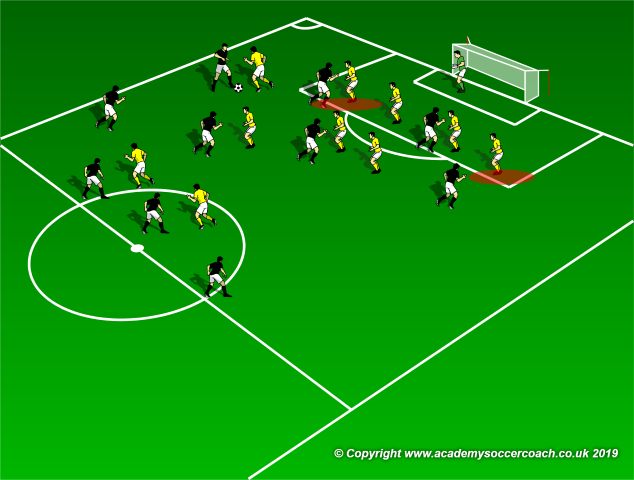
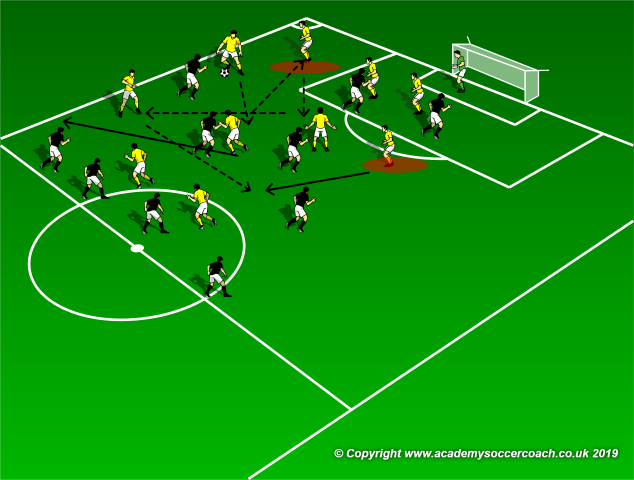
Note above the movement of the outside backs and midfielders has created a 6 v 3 around the ball. Drilling this is easily done in a half field with an 8 v 5 activity.
Set Up
As shown below, 8 defenders ( yellow ) who will set up to possess out of pressure play against 5 attackers ( black ). 4 defenders start in the box vs 2 attackers. The two attackers and the two defenders marking them must stay inside the penalty box. To start play, the keeper rolls a ball out to a waiting wide defender. When the ball is rolled 3 additional attacking midfielders may enter play along with 3 additional supporting defending players. As the movement arrows show, the support coming from the outside backs should provide ample possession opportunities for the yellow side.
Start by having the yellow side make 10 passes before resetting. As the yellow side is able to increase the ease of which they play out, add up to 2 attacking players and increase the pressure on the initial service from the keeper. As a final progression, play can start with a service from the keeper which is a 50/50 ball in the half field. If the yellow side wins they play to make 10 passes, if not, they drop in to defend. However, anytime they win the ball, they ( the yellow side ) should attempt to play out with a focus on the supporting movement of the outside backs.
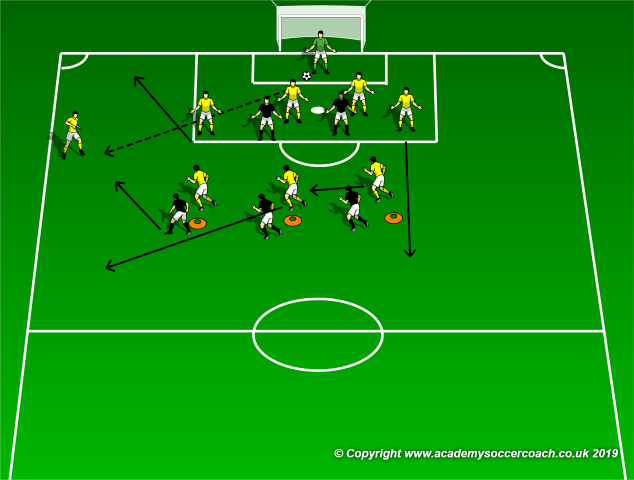
Coaching Points
Again, the focus here is the supporting movement of the outside backs. Yes, the two attacking forwards will be singled up without cover but POSSESSION is the extra defender here. If the attackers can’t get the ball, they can’t score. The coach should push the outside backs to be aggressive in seeking the supporting space.
Holding Possession In Midfield
The idea here is simple, but not easy. In my experience with high school teams, it will take 3 to 4 midfielders working as a unit to control the midfield space. The problem is, a lot of young players want to “ run away” from the play, usually in anticipation of a long ball, instead of moving to support AND coordinating those movements with the other midfielders. ( as shown with the motion arrows below ). Note the two midfielders shaded in red: to support possession, the wide player MUST be available on the line and there must always be a central players simply checking too and away to always provide a passing angle to the player on the ball.
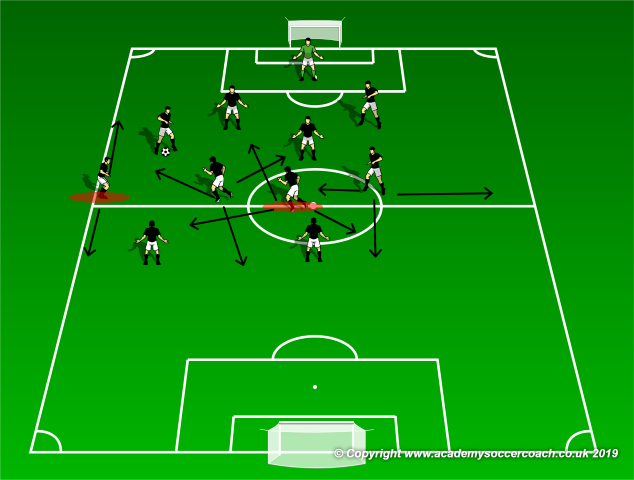
Here is an easy activity to work on this coordinated support:
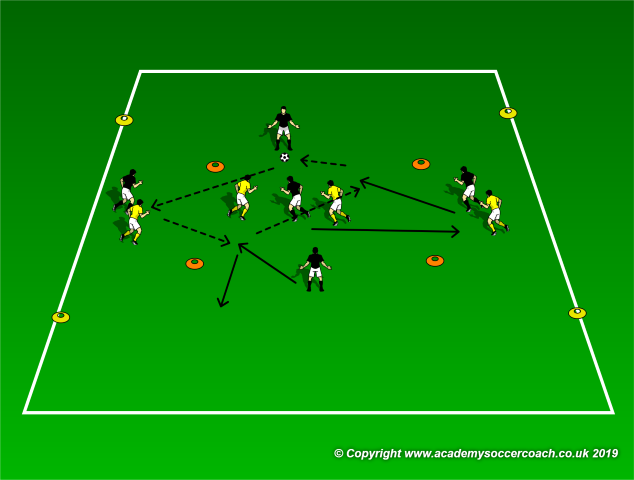
As shown above, 5 attacking players possess against 4 defending players in two grids. Two defenders must stay in the central grid and cannot interchange during play with the two defenders in the outer grid. The attacking players can interchange between the grids at will, but one attacker must be in the center grid at all times. The two defenders in the large grid may move around and defend any of the attackers in the large grid.
The idea is for the attacking team to move the ball in and out of the small grid, creating space with good supporting movement. There should always be an attacking player checking into and out of the small grid. Good movement can create a 4 v 1 or even a 4 v 2 against the defenders in the small grid. Pressure can be adjusted by adding or removing defending players and with good movement this can actually be a great drill to try with the attackers playing down a man to the defending side. By restraining an additional defender to the center grid as well as an addition defender to the large grid, 5 attackers with good movement, touch and communication can keep the defenders running in circles.
Holding Possession In Front Of Goal
The diagram below shows what I call “ perfect shape”. The key to this is keeping the ball moving and the interchange of the outside players on the ball side combined with the interchange of the central players. Drilling this is just as simple as setting it up in a half field and putting a few restrictions on each team to create the desired effect. I like to play with 7 defenders, simulating the back and midfield lines of a 4-3-3, and I keep these players central ( between the edges of the penalty box) thus giving the attacking side the wings.
For the attackers, the ball must stay on the ground – no long services or switches, and no scoring attempts until the ball has been switched on the ground AND every attacking player has touched it. These type of restrictions allow the coach to focus the team on movement and passing, not just shooting.
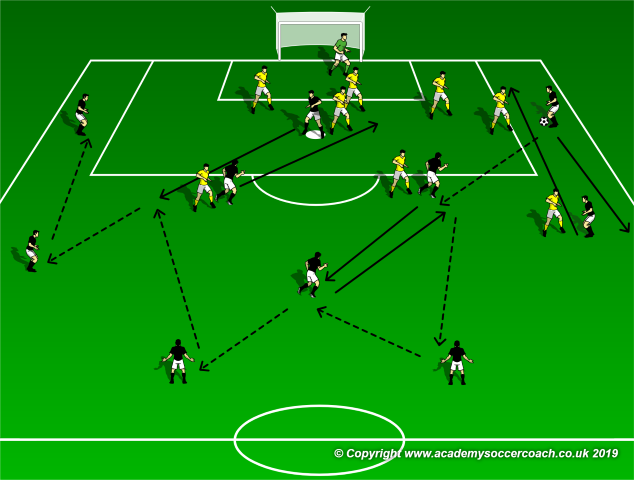
Coaching Points
Make sure the central players are keeping a diamond shape, with one always in the box , two supporting the wing play on both sides and one supporting the back line. Wide players should immediately pass and move using overlapping and dropping runs and the two central deep players should communicate with the others constantly while looking to make quick distributions to open players. Once the attacking team can keep the ball continuously , add defending players up to a full opposing side.
By Mike Smith
Currently the Head Coach for University Heights Academy Boys Soccer in Hopkinsville, KY , Mike is in his 14th year as a high school head coach with 23 years coaching experience overall and 34 year as a student and fan of the game. He holds a USSF D License.


